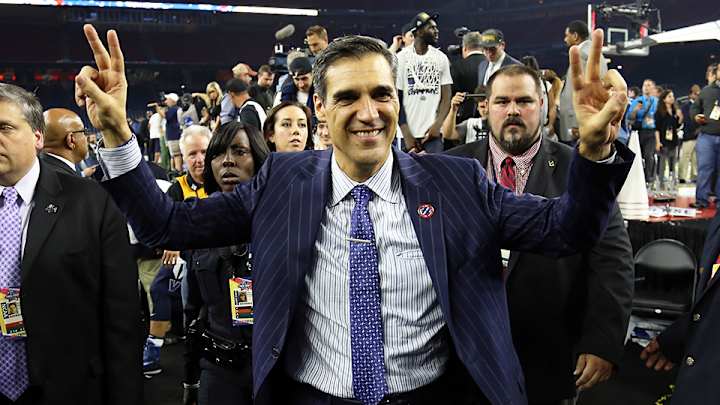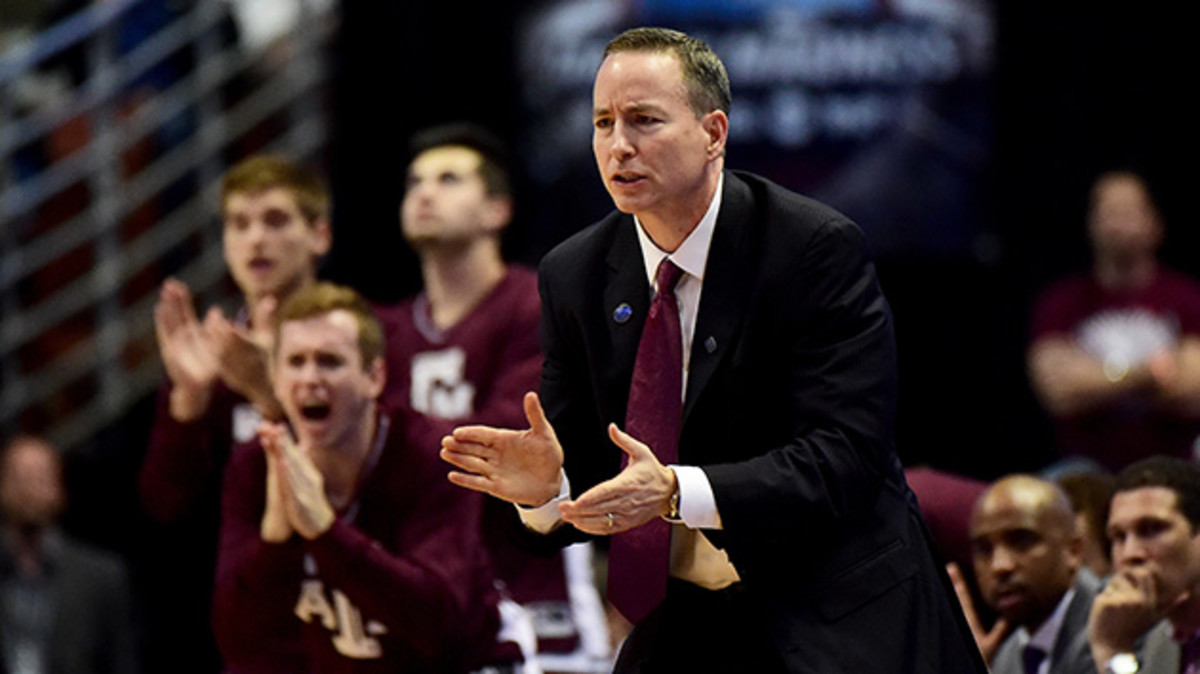The 2016 Effy Awards: Chris Beard, Jay Wright among coaching winners

Get all of Luke Winn’s columns as soon as they’re published. Download the new Sports Illustrated app (iOS or Android) and personalize your experience by following your favorite teams and SI writers.
SI presents The Effys: the least ambiguous and least prestigious postseason awards in college basketball. Every award is based on efficiency or other advanced metrics. No voting—just analytics.
(For the first three seasons, these were called the Data-Based Awards, which also made them the least-cool-sounding honors in the sport. That has been rectified, or at least I hope so. Past editions:2014–15,2013–14, 2012–13, 2011–12, 2011–12)
Part 1: The Coaching Effys
1. Effy Coach of the Year: Jay Wright, Villanova
Wright presided over the most dominant NCAA tournament run of the analytics era (2002-present)—a six-game streak in which the Wildcats outplayed opponents by an adjusted plus-52.9 points per 100 possessions. Those three staggeringly excellent weeks of NCAA tournament play were preceded by a regular season in which ‘Nova ranked fifth overall in efficiency according to kenpom.com, and was one of just three teams (along with Kansas and Virginia) to rank in the top 15 in both adjusted offensive and defensive efficiency. Wright also broke new ground in the ongoing Three-Point Revolution: His Wildcats took the highest percentage of their field-goal attempts from long range (42.7%) of any champ since the line was introduced in 1986–87.
2. Biggest One-Year Turnaround: Chris Beard, Little Rock
Beard left Angelo State, a Division II school in Texas, to take over a Little Rock team that went 13–18 and ranked 223rd in efficiency in ‘14–15. The Trojans finished this season 30–5 and ranked 51st in efficiency—and they upset Purdue in the first round of the NCAA tournament. Beard improved UALR’s Pythagorean winning percentage by 42.4 points (from 36.6 to 80.0), the highest one-year jump of any coach this season. That he was in demand for multiple jobs this off-season—first accepting the gig at UNLV, then jumping ship once his former employer, Texas Tech, had an opening in April—was no surprise.
3. Biggest One-Year Turnaround, Major Conference: Buzz Williams, Virginia Tech
Duke, Villanova lead Way Too Early top 25 for 2016–17 season
Williams hasn’t broken through to the NCAA tournament yet at Virginia Tech—that could very well happen next season, which will be his third in Blacksburg—but he has shown significant progress in his makeover of the Hokies. They jumped 127 spots in kenpom’s efficiency rankings (from 184th to 57th), the most of any major-conference team—and they made a 173-spot leap in adjusted defensive efficiency. The only other major-conference team with a triple-digit jump in its overall efficiency ranking was Texas Tech, whose coach, Tubby Smith, parlayed that breakout into a five-year, $15.45 million contract at Memphis.
4. Biggest Two-Year Turnaround: Kevin Keatts, UNC-Wilmington
When Keatts, a former Louisville assistant, took over in ‘14–15, the Seahawks were coming off a 9–23 season in which they ranked 278th in efficiency. In two years, Keatts orchestrated a 205-spot jump in UNC-W’s efficiency ranking—the largest two-year improvement by any coach—and earned a trip to the 2016 NCAA tournament. That represented quite a rise for someone who, five years ago, was coaching at Hargrave Military Academy, a boarding school in Chatham, Va.
5. Biggest Two-Year Turnaround, Major Conference: Billy Kennedy, Texas A&M
Virginia Tech’s Buzz Williams has a case for winning this award, as his team finished a major-conference-high 135 spots better in efficiency than where it was two years ago. But in the same span, Kennedy took a major-conference team from mediocre (121st in efficiency, ninth place in the SEC) to elite, which is arguably is the most difficult type of breakthrough. His Aggies finished ‘15–16 ranked 19th in efficiency, tied Kentucky for the SEC regular-season title, and reached the Sweet 16 as a No. 3 seed in the NCAA tournament.

6. Best At Exceeding Projections: Nicholas McDevitt, UNC-Asheville
The NCAA tournament team that SI’s Preseason Projection System missed the most on was McDevitt’s Bulldogs. Our system saw their go-to scorer from ‘14–15, Andrew Rowsey, transfer to Marquette, and their top rebounder and rim-protector, Jaleel Roberts, run out of eligibility, and forecasted a fifth-place finish in the Big South and 248th ranking overall. But UNC-Asheville leaned on two unheralded freshmen (guards Dwayne Sutton and Dylan Smith) and a starting lineup with no one taller than 6'5" to finish as the conference’s most efficient team (with a No. 122 overall ranking) and reach the NCAA tournament as a No. 16 seed.
7. Best At Exceeding Projections, Major Conference: Kevin Willard, Seton Hall
SI’s projections pegged the Pirates as the 80th-best team in the preseason, forecasting a seventh-place finish in the Big East, well outside of the NCAA tournament bubble. Seton Hall ranked 146th in defensive efficiency in ‘14–15, wasn’t adding a rim protector, and was losing its one truly efficient scorer, Sterling Gibbs, who made a graduate transfer to UConn. Things didn’t look promising from the outside—but Willard worked magic with his defense, getting the team to recommit to playing tough man-to-man, and relying on defense-focused lineups that included UMass transfer Derrick Gordon and sophomore lockdown artist Ismael Sanogo. Seton Hall finished with the nation’s No. 8-ranked D, was 22nd in efficiency and a No. 6 seed in the NCAAs—a body of work that, regardless of the Pirates’ first-round exit from the NCAAs, should be considered a major success.
8. Best At Exceeding NCAA Tournament Projections: Jim Boeheim, Syracuse
Boeheim’s Orange were a No. 10 seed that may not have even deserved an at-large bid; analytics aren’t necessary to prove they were the most surprising team in the Final Four. But according to kenpom’s NCAA tournament log5 probabilities, Syracuse opened the tourney with just a 1.5% chance to make it to Houston—a far more unlikely scenario than the chance of Villanova winning it all (7.3%) or No. 15 Middle Tennessee State upsetting No. 2 Michigan State in the first round (7.8%). The Blue Raiders’ shocker certainly made Syracuse’s path to the Final Four easier, but it still had to get through Gonzaga and Virginia, and in the Elite Eight game against the Cavaliers, the Orange’s win probability odds had dropped to 2% with just under 10 minutes left in the second half.
9. After-Timeout Efficiency King: Tony Bennett, Virginia
Ranking the five best title games of the 64-team era
It’s a bizarro season when Bennett is winning offensive, rather than defensive, awards. But the master of the Pack-Line D had a great scoring team this season, and when strength-of-schedule adjustments are applied to Synergy Sports Technology’s after-timeout efficiency logs, Bennett’s Cavaliers come out on top. They scored an adjusted 1.065 points per possession in ATO situations, edging out an ACC team known for its offense (Notre Dame, at 1.063) and the national champion (Villanova, at 1.058). Having two highly efficient go-to seniors in guard Malcolm Brogdon and forward Anthony Gill helped Bennett’s case, but his team’s halfcourt execution was noticeably impressive, even with elite personnel.
10. After-Timeout Efficiency King, Outside Major Conferences: Matt Brady, James Madison
The No. 4 team in adjusted ATO efficiency—and No. 1 outside of the major conferences—was a surprise: James Madison, which finished 123rd in overall offensive efficiency. The Dukes weren’t a killer offensive team in the halfcourt, but Brady found ways for them to get good looks, including plenty of open threes, in ATO situations. Brady did not get an appropriate reward for his efficient play-calling and 21–11 record, however: He was fired on March 14 after the conclusion of his eighth season at JMU.
11. First-Year Coach Who Vowed To Play Uptempo, Actually Did It—And Did It Well: Linc Darner, Green Bay
The biggest tempo turnaround by any new D-I coach, by a massive margin, was Duggar Baucom at The Citadel, where he took over a team that averaged 59.3 possessions per game (ranking 344th nationally) and revved it up to 81.5 (ranking first). But Baucom’s Bulldogs went 3–15 in the Southern Conference, so in that case, speed did not instantly translate into success. Darner’s debut season at Green Bay yielded better results. He sped the Phoenix up from 65.4 possessions per game (ranking 142nd) to 76.7 (sixth), and they pulled off a series of upsets in the Horizon League tournament to make the school’s first NCAA tourney appearance since 1996.
Part II, The Player Effys, will run next week on SI.com.
